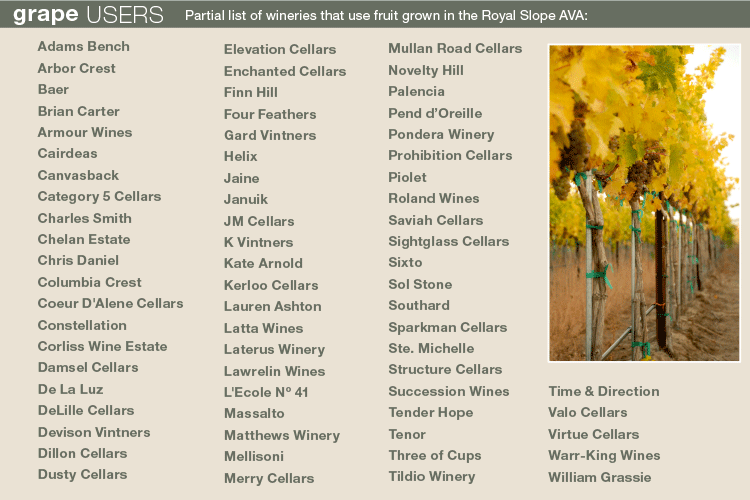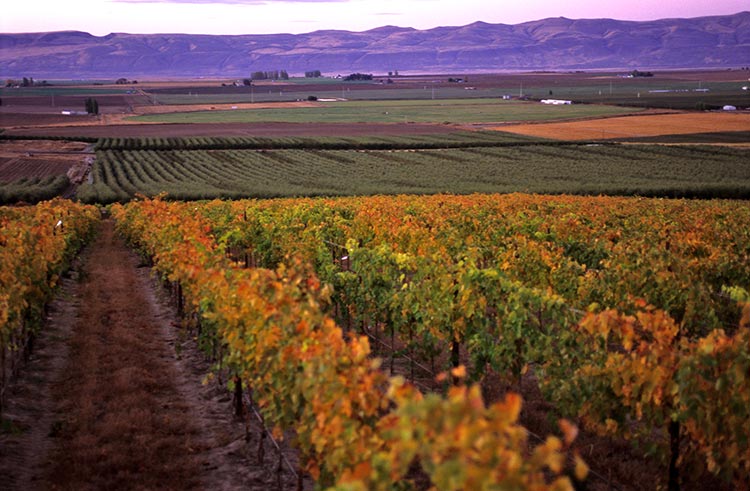
Written by John Vitale
ROYAL SLOPE became the 15th official American Viticultural Area (AVA) in Washington on September 2, 2020. With a handful of older vines that date back to the early 1980s, most plantings are less than two decades old. Already this agricultural region has quickly become an important stronghold for growing wine grapes; there are currently 1,900 acres planted throughout the AVA, producing an impressive range of red and white varietals.
Editor’s note: Click here for reviews of 28 wines made with grapes sourced from the Royal Slope AVA
Growers like Steele Brown, owner of Golden West Vineyards, are bullish about the prospects. He tells Washington Tasting Room Magazine that he hopes to continue planting new vines every year. Over the past six years Steele has planted 500 acres of Pinot Noir for vintner/entrepreneur Charles Smith. It’s notably the largest Pinot Noir planting in the history of Washington State.
Charles Smith drew attention to the Royal Slope after receiving a 100-point score for his 2006 “Royal City” Syrah, named for the town in the AVA. His single-vineyard Chardonnay project, Sixto, in collaboration with talented winemaker Brennan Leighton, uses grapes from Frenchman Hills, one of the older vineyards in the AVA planted in the late 1990s. Smith and Leighton rely on fruit from this region for the K Vintners label as well.
Fast Facts: Royal Slope AVA
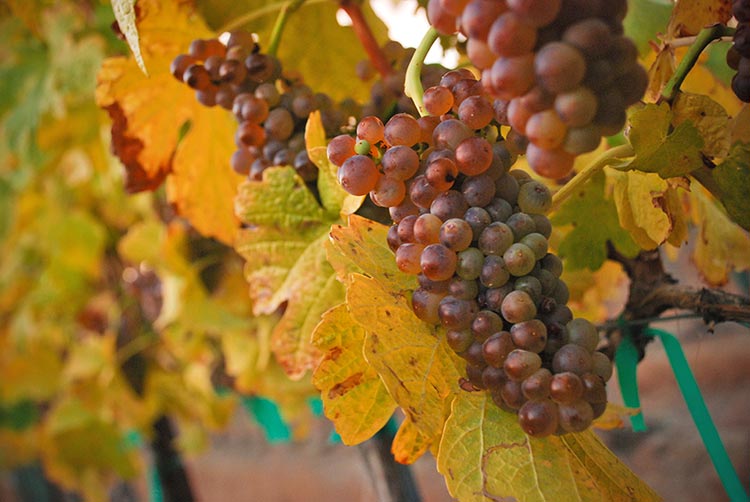
• Date federally approved American Viticultural Area: September 2, 2020
• Date of first commercial winegrape plantings: Circa 1980
• AVA landmass: 156,389 acres
• Vineyard plantings to date: 1,900 acres
• Where: East-central Washington, covering portions of Adams and Grant Counties
• Significant growers:
Lawrence Vineyards (450 acres), Frenchman Hills (468 acres), Golden West (500 acres), Stillwater Creek (230 acres)
• Top red varietals:
Cabernet Franc, Cabernet Sauvignon, Cinsault, Grenache, Malbec, Merlot, Mourvèdre, Petit Verdot, Pinot Noir, Sangiovese, Syrah, Tempranillo
• Top white varietals:
Albariño, Chardonnay, Chenin Blanc, Gewürztraminer, Grüner Veltliner, Pinot Gris, Riesling, Roussanne, Sémillon, Sauvignon Blanc, Viognier
• Number of wineries using Royal Slope fruit: 70+
• Number of Tasting Rooms to date: 3
The grapes for Charles Smith’s 100-point Syrah came from Stoneridge Vineyard, a unique site with cobbly, gravelly soils that is sustainably farmed by Josh and Lisa Lawrence. Born and raised on his family’s farm in Royal City, Josh Lawrence is one of the pioneers of this winegrape region; he started planting vineyards in 2003 and spearheaded the federal petition to be granted AVA status. He and his wife run Lawrence Vineyards, a collection of distinctive vineyard sites. In addition, they produce their own wines under Gård Vintners, with tasting rooms in Walla Walla, Woodinville, Ellensburg and Gård Public House in downtown Royal City.
Today Josh Lawrence manages 450 acres of vineyards in the AVA and is a staunch believer in the high quality of fruit grown here. “The Royal Slope probably should have been an AVA 10 or 15 years ago,” he affirms, pointing to the competition for apple crops more than anything. His family was among the early apple growers back in 1980, before every large packing shed in the state arrived a decade later. “It’s probably the best place in the state, if not the country or the world to grow apples. So the wine grapes didn’t take hold earlier like they could have because there was so much competition from other permanent crops. But if we could grow phenomenal apples, why couldn’t we grow phenomenal wine grapes?”
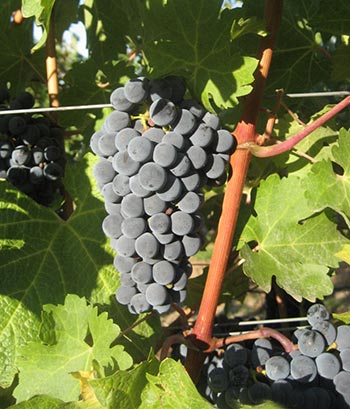
Lawrence supplies grapes to K Vintners and at least 35 other successful wineries (including his own Gård wines). “To us, we want to see people succeed with our grapes. We believe in the rising tide approach. If we’re knocking it out of the park with our grapes, we hope that it pays off for everybody buying grapes from us and vice versa,” he says. Among his clientele are Matthews, Tenor, Mullan Road, Cairdeas, Canvasback, Columbia Crest, Jaine, Lawrelin, Succession, Kerloo, and Ste. Michelle, to name a few.
Royally Unique Growing Region
The Royal Slope is tucked between two other prominent growing regions. Ancient Lakes is immediately to the north in the Quincy Basin where mostly white varietals are grown, influenced by the cooling effect of the Columbia River. Just to the south of the Saddle Mountains lies the Wahluke Slope, known to be a generally drier, hotter site where red varietals comprise 80% or more of all plantings.
A satellite view of the Royal Slope reveals a compact grid of green-hued crop circles, geometric-shaped vineyard and sage-colored desert farmlands that extend northward from Royal City, rising upwards from 610 feet in elevation up the south-facing slopes to 1,756 feet at the ridge of the Frenchman Hills. This is notably higher than the surrounding growing regions.
“I think we get a little bit of marine influence here. Just being up 1,400 feet has a lot to do with it, and being further north than most of the other growing regions,” says Ed Kelly, who has been managing Stillwater Creek Vineyard in the AVA since 2011. Approaching his 43rd harvest, Kelly has spent much of his career growing premium wine grapes throughout Napa, Sonoma and Mendocino.
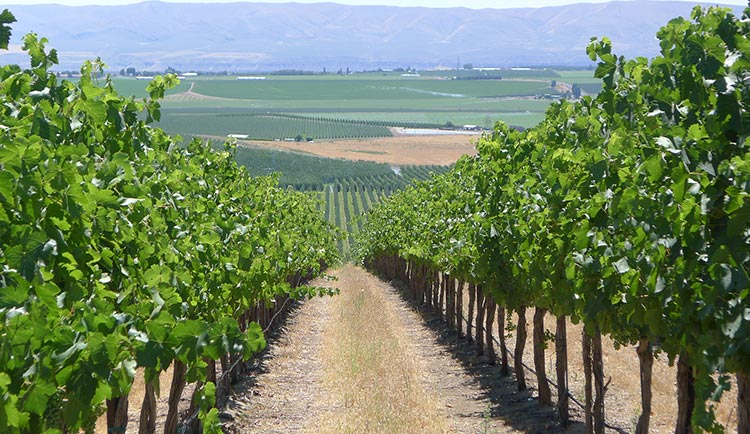
Kelly believes the higher altitude plays a role in being able to successfully grow both red and white varietals. “I have a theory that we stay a little cooler than the Wahluke Slope, which is about 10 miles south of us. Because of Snoqualmie Pass, all that wind comes over. Ellensburg is known for being windy and I think a lot of that cool air gets sucked in here over the Snoqualmie Pass and flows down through Ellensburg, where it hits the Vantage area—and that’s the start of the Frenchman Hills.”
Wines coming from the Royal Slope, both red and white varietals, display a beautiful combination of fruit and depth of complexity, with a nice punch of acidity that comes up from the bottom.
“This is one of the most unique places I have ever grown grapes. I have never in my life grown 16 different varietals that produce 90-plus rated wines, from whites, Bordeaux, the Rhônes—it can grow them all well,” concludes Ed Kelly.
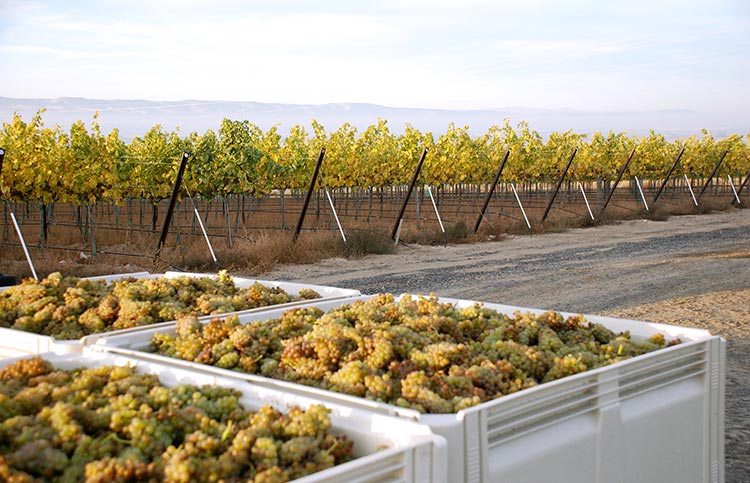
Not Too Cool, Not Too Hot
Josh Lawrence agrees the Royal Slope differs from the surrounding AVAs in terms of heat units. “We are very fortunate to be able to grow whites and reds equally well in an area that’s sandwiched between a predominantly red region and a predominantly white region,” he says. “To the north it’s so much cooler that you don’t see many reds growing in the Ancient Lakes. There are reds grown there but it’s definitely better for white varietals like Riesling, Sauvignon Blanc and Chardonnay. And then you go south to the Wahluke Slope where it’s Cabernet driven, and it’s too hot to grow Riesling,” he says.
This was one of the reasons behind the petition to gain official AVA status, especially in Washington State where so many growing regions are lumped into the larger Columbia Valley AVA. “There is so much difference from the top of the Columbia Valley to the bottom, and to the east and west. And the Royal Slope is one of those great examples,” states Josh. “We range from 1700-plus feet elevation to under 700 feet elevation, and the soil types vary within those ranges. We are lucky to potentially grow world-class Riesling and world-class Cabernet in the same AVA.”
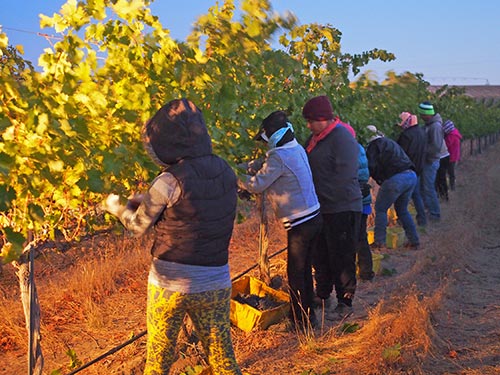
A Royal Name
Josh Lawrence’s father and uncle started farming the area in 1965, shortly after Royal City was founded in the mid-1950s. However the name ‘Royal Slope’ has been on maps for close to 100 years or more, designated as such by generations of farmers that lived in the area. One story of the origin of the region’s name is that a pair of Scotsmen climbed the nearby Saddle Mountains in the early 1900s. As they surveyed the topography below, with its south-facing slopes that were desirable for farming, one of the men was purported to have exclaimed, “Now that’s a royal slope!” The name stuck.
“It ended up being a pretty damn good name when it comes right down to it—it has a ring,” says Lawrence.
